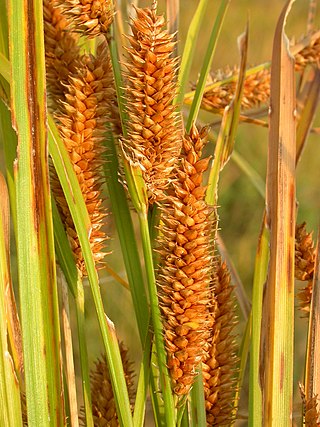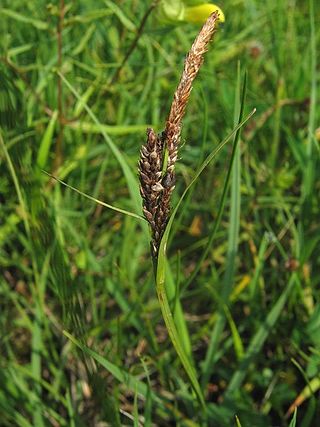
Ornamental grasses are grasses grown as ornamental plants. Ornamental grasses are popular in many colder hardiness zones for their resilience to cold temperatures and aesthetic value throughout fall and winter seasons.

Carex is a vast genus of more than 2,000 species of grass-like plants in the family Cyperaceae, commonly known as sedges. Other members of the family Cyperaceae are also called sedges, however those of genus Carex may be called true sedges, and it is the most species-rich genus in the family. The study of Carex is known as caricology.

Carex flacca, with common names blue sedge, gray carex, glaucous sedge, or carnation-grass,, is a species of sedge native to parts of Europe and North Africa. It is frequent in a range of habitats, including grasslands, moorlands, exposed and disturbed soil, and the upper edges of salt marshes. It has naturalized in eastern North America.

Carex chordorrhiza, commonly called creeping sedge or string sedge, is a species of perennial plant in the family Cyperaceae with Holarctic distribution growing in acidic bogs.

Carex hassei is a species of sedge known by the common name salt sedge. It is native to western North America from British Columbia to Baja California to New Mexico, where it grows in moist places, such as meadows.

Carex leptalea is a species of sedge known by the common names bristly-stalked sedge and flaccid sedge. It is native to much of North America including most of Canada, the Dominican Republic, and the United States. It only grows in wetlands. This sedge produces dense clusters of thin stems up to 70 centimeters tall from a network of branching rhizomes. The thin, deep green leaves are soft, hairless, and sometimes drooping. The inflorescence is up to 16 millimeters long but only 2 to 3 millimeters wide, and is yellow-green in color. There are only a few perigynia on each spikelet, and they are green and veined.
- Carex leptalea subsp. harperi(Fernald) W.Stone - southeastern US from Texas and Florida north to Missouri and Pennsylvania
- Carex leptalea subsp. leptalea - widespread from Alaska east to Nunavut and south to California and Dominican Republic
- Carex leptalea subsp. pacificaCalder & Roy L.Taylor - Washington State, British Columbia, southeastern Alaska

Carex leporina is a species of sedge known in the British Isles as oval sedge and in North America as eggbract sedge. It is native to Eurasia and eastern and western North America, where it grows in seasonally wet habitat, such as meadows and fields. This sedge produces many thin stems and narrow leaves. The inflorescence is an open cluster of several flower spikes. The pistillate flower has a reddish or brownish bract with a gold center and white tip.

Carex praegracilis is a species of North American sedge known as clustered field sedge, field sedge, and expressway sedge. Carex praegracilis is cultivated in the specialty horticulture trade as lawn substitute and meadow-like plantings.

Carex rossii, commonly known as Ross's sedge, is a hardy species of sedge that is often a pioneer species in areas with little or no established vegetation, or in places where disturbance has occurred. Ross's sedge grows in a variety of habitats throughout much of western North America, from Alaska to Ontario, south to New Mexico and California. It flowers in May and June.

Carex scoparia is a species of sedge known by the common names broom sedge and pointed broom sedge. It should not be confused with the unrelated grass species known as "broom sedge," Andropogon virginicus.

Carex utriculata is a species of sedge known as Northwest Territory sedge and common yellow lake sedge.

Carex pensylvanica is a species of flowering plant in the sedge family commonly called Pennsylvania sedge. Other common names include early sedge, common oak sedge, and yellow sedge.

Carex bigelowii is a species of sedge known by the common names Bigelow's sedge, Gwanmo sedge, and stiff sedge. It has an Arctic–alpine distribution in Eurasia and North America, and grows up to 50 centimetres (20 in) tall in a variety of habitats.

Carex vaginata is a species of sedge known by the common name sheathed sedge.

Carex panicea, commonly known as carnation sedge, is a plant species in the sedge family, Cyperaceae. It is known as grass-like sedge and can be found in Northern and Western Europe, and also in north-eastern North America. The plant produces fruits which are 3–4 millimetres (0.12–0.16 in) long, are egg shaped and spiked. Both male and female species leaves are pale blue on both sides.

Carex eburnea, known as ivory sedge, ebony sedge, and bristleleaf or bristle-leaved sedge, is a small and slender sedge native to North America, from Alaska and Newfoundland south to central Mexico.

Carex kobomugi is a species of sedge, known as the Japanese sedge or Asiatic sand sedge, that lives in sandy coastal areas of eastern Asia, and has become an invasive species in the north-eastern United States.

Carex elata, tufted sedge, is a species in the genus Carex, native to all of Europe, the Atlas Mountains of Africa, Turkey, Iran and Central Asia. It prefers to grow with its roots in water. Its cultivar 'Aurea' has gained the Royal Horticultural Society's Award of Garden Merit.



















